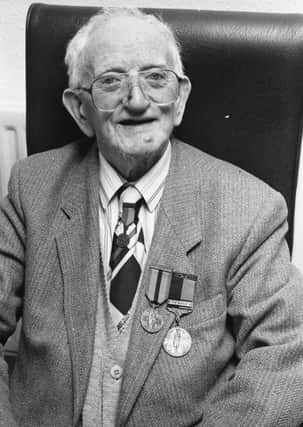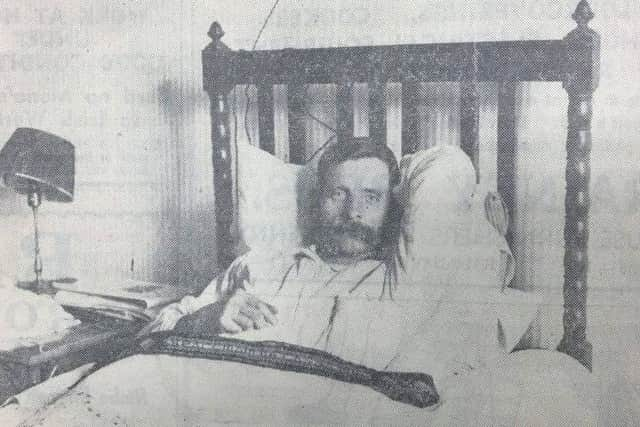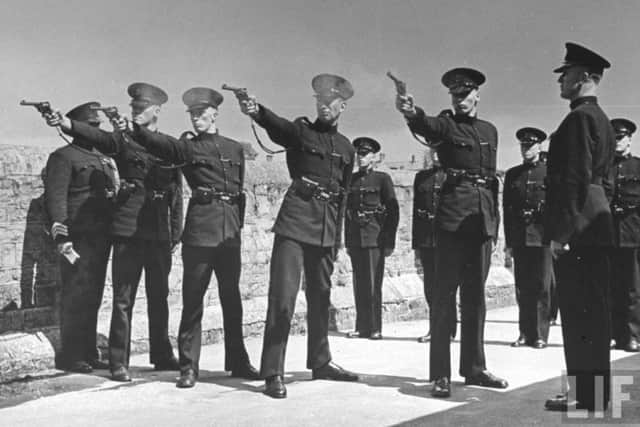The final chapter of the story of Derry Irish Volunteer and writer Liam A. Brady


“The first nationalist Mayor of the City, Hugh C O’Doherty, in discharging his duty as well as his ability was admitted by all sides to be one of the noblest citizens who ever occupied the Mayoral chair and none before him, or since, filled the office with the same fairness to every creed and class. There was no discrimination against any section of the community and the offices of the city were conducted with marked efficiency.
Mayor O’Doherty proved that fair treatment is not incompatible with the uncompromising profession of the Mayor’s own political opinions.
Advertisement
Hide AdAdvertisement
Hide Ad“He respected the political convictions of those who disagreed with him but at the same time he did not lower the flag of an independent Ireland. He never hesitated to voice his sympathy with the republican cause in the Anglo-Irish War days or to express his protest against the methods by which Lloyd George tried in vain to subdue the Irish people. The causes of republican prisoners always found in him a warm champion.


“For instance when the wife of the late Seamus Cavanagh received a message that he was gravely ill as a result of a hunger strike, Mayor O’Doherty sent the following telegram to the British Home Secretary: ‘James Cavanagh, citizen of Derry, deported Wormwood Scrubs without reason, reported dangerously ill from hunger strike. Call upon Govt for release-HC O’Doherty, Mayor’.
“Seamus Cavanagh was released that night in a state of collapse and was conveyed by ambulance to a nursing home in the West End of London, where he remained until his recovery.
“No sooner was the Anglo-Irish Treaty set in motion than the Six County Government received instructions from Britain that all noted republicans living in the Six County area were to be arrested and interned irrespective of whether they were anti-treaty of treaty supporters. Word was received through secret channels, but the republicans discovered the plot. In Derry City scores went on the run. Others crossed the border and were absorbed into the two opposing camps which the Treaty had created. There were those who were warned but who had not heeded the warning, while there were others who were unaware of what was in store for them.
Advertisement
Hide AdAdvertisement
Hide Ad“They were dragged from their homes in the middle of the night in hundreds and lodged in Belfast and Derry jails. Others were sent to the old obsolete cargo ship the ‘Argenta’. While this was going on the Orange Special Constabulary otherwise known as the A, B and C Specials carried out systematic raids everywhere and all organisations of national character were suppressed. Religious discrimination became evident and liberal-minded Protestants had to become members of the B Specials by threat of losing their employment and being ostracised by their friends.


“Let us now examine what the ordinary prison rules and discipline in the Six Counties consisted of. The internees were subjected to forms of hardship and privation. They were practically in solitary confinement, being locked alone in their cells for 20 hours a day. The other four hours were dedicated to walking exercise from 10 o’clock until twelve noon and from 2 o’clock to 4 o’clock when each was locked up in his cell until 10 o’clock the following morning, with the lights turned out on week nights at 8.30 on weeknights and 7.30 on Sundays.
“These cells averages 9ft x 6ft and were badly lighted and ventilated with totally inadequate heating. The walking exercise consisted of a single file parade around the jail yards on concrete paths 18 inches wide and to let one’s foot slip off this path and touch the grass, even by accident was to punishable by three days bread and water with solitary confinement.
“The food was of the worst possible description and served under revolting conditions without knives or forks. While the beds and clothing were of the hardest and commonest character-boards with a rough, fibrous mattress and two rags for blankets without sheets or pillows.
Advertisement
Hide AdAdvertisement
Hide Ad“Parcels were not permitted. Newspapers were never seen and the internees knew little of what was happening outside as the letters they received were so mutilated by blackened lines or cut-outs that they looked more like jig-saw puzzles at times.


“The Orange B Specials were posted all over the place. The occupied the balcony overlooking the daily exercise in the yards and paraded through the corridors with rifles at night. On several occasions they turned on the gas, which connected to each cell by the old-fashioned burner type without mantle and nearly gassed a number of internees in the cells. The internees made arrangements that as soon as any person smelled gas he was to hammer on the so-called hot pipe and shout until the chorus was taken up by all other internees. In that way they would attract the attention of the Governor and night warders, who if necessary would turn off the gas and the internees could settle down in safety for the rest of the night.”
In the last few months to coincide with the 100th anniversary of the Easter Rising of 1916, the ‘Journal’ has reprinted a series of articles by Liam Brady who was a member of the Republican Movement in Derry in the tumultuous years from 1913-1923.
The articles which first appeared in this paper in 1953 and throughout these we learned how Liam Brady was appointed leader of the Fianna in Derry in this era and later went on to become an IRA Volunteer.
Advertisement
Hide AdAdvertisement
Hide AdBack in 1991, when Liam Brady was 91-years-old, the late journalist Domhnall MacDermott interviewed the republican about his life and times. It is worth nothing that Domhnall MacDermott’s grandfather, Eamonn MacDermott was, in fact, adjutant of the Volunteers in Derry in this era and was imprisoned for a period in 1916 with almost 2,000 others by the British at Frongoch Camp in Wales.


Liam Brady was born and raised in Derry’s Waterloo Street with his seven brothers and five sisters. In later years whilst acting as a dispatch rider between Derry and Gweedore he met his future wife Catherine McKelvey who was member of Cumann Na mBan in her native Cummeen, at Doochary.
This interview took place again the backdrop of the 75th anniversary of the 1916 Rising and is a very fitting way to conclude the ‘Journal’s’ look back at the life and writings of Liam Brady.
On Friday, May 4, 1991 Domhnall MacDermott wrote: “Liam Brady remembers one occasion on which Dan McGandy was interrupted (stealing hand grenades from a local engineering works on behalf of the IRA) by British soldiers and a fight broke out. He struggled with three soldiers and fell into the Foyle. Although a strong swimmer, he was overpowered and drowned.
Advertisement
Hide AdAdvertisement
Hide Ad“The Fianna’s work was now carried out secretly and Liam spent a lot of time delivering messages and supplies to men on active service in Derry and Donegal. On one occasion Liam was told by Paddy Hegarty, who owned a tobacconists shop, to deliver two parcels, one containing cigarettes and tobacco to the RIC Station and the other containing ammunition and detonators to Eamonn McDermott. On his way, he met some friends and began chatting - not thinking what he was doing he went into the police station and left off a parcel.
“On leaving the station he decided for some reason to check the parcel to be delivered to Eamonn MacDermott. He realised, to his horror, that he had handed the sergeant the wrong parcel. With ruin facing himself, Paddy Hegarty and Eamonn MacDermott, Liam walked calmly back into the station where he found to his relief that the sergeant had not opened the parcel yet. He was able to exchange parcels and nonchalantly walked out.
Never again would he be so careless with items he was delivering for the Fianna.
“When the Treaty was signed, the Fianna voted it against it and along with the majority of the Derry IRA opposed partition. Liam was arrested by Free State forces in Buncrana and interned for some months at Drumboe Castle.”
Advertisement
Hide AdAdvertisement
Hide AdMr Brady was in fact the last prisoner to be released from Drumboe Castle near Stranorlar. The castle was the Donegal headquarters for the Free State forces and it is infamous for being the location of the Drumboe massacre during the Irish Civil War. On March 14, 1923, four anti-Treaty IRA fighters, Charles Daly (26), Sean Larkin (26), Daniel Enwright (23), and Timothy O’ Sullivan (23), who had been captured and held in the castle since January, were summarily shot in retaliation for the death of a National Army soldier in an ambush.
Liam Brady was quoted in the ‘Journal’ in 1991 as saying: “I was held two weeks longer than I should have been after the order for a General Release. I had known the man commanding the jail from the ‘Tan’ years and he was around making an inspection of the jail. He was talking to the Free State guards and they told him he had seen everyone except one prisoner.
This was two weeks after the General Release and everyone else had been let out. He said ‘what do you mean, prisoner?’ and they brought him to see me. He asked me what happened and told the guards to give me as much food as I wanted. Then they asked me if I was fit to go and escorted me to the train.’
‘At Drumboe Castle we were held 16ft below ground level. There were rats that came into our cells at night. Now, not being too fond of rats, I wasn’t too pleased about that. However, the rats were well fed with all the food the Free State guards left lying around and only came into our cells for warmth. True enough, they’d get as close to you as possible but I never saw them touch anyone.’
Advertisement
Hide AdAdvertisement
Hide AdHaving been held for three months, Liam was released and headed to Waterloo Street in Derry, much to the surprise of his family who had not seen him for some time.
In 1924, Liam applied to be put on the Electoral Register for Northern Ireland but was informed by the Deputy Registration Officer that he could not be included because he was not a British subject. Ironically, in 1945 when he applied to the Department of Industry and Commerce in Dublin for employment assistance, he was living with his wife and daughter in Doochary at the time, he was refused on the grounds that he was not a native of Ireland.
Domhnall MacDermott’s article continues: “While the years of involvement with the republican struggle are obviously the one’s that remain most vivid in Liam’s mind, it would be a mistake to think of him as just an ‘old IRA man’.
Over the year’s Liam developed an interest in a number of fields including chemistry, geology, history, theology and archaeology.
Advertisement
Hide AdAdvertisement
Hide Ad“In 1935 he presented the Royal Irish Academy with pottery shards he’d discovered at Magheragallon sand hills and over the years has contributed to a number of naturalists discussion groups.
“However his most abiding interest was chemistry and dated back to his childhood. One day along with his friend Oreste Macari he discovered that if sulphur was mixed with heated saltpetre a bright flash is created. This led to a vow by the two young boys to become chemists. While Oreste went on to become a chemical engineer with Pirelli in Italy, Liam didn’t quite make it.
“He continued to communicate with his friend over the years and at one stage the two of them considered a process of purifying rubber that Liam had developed. Oreste Macari was interested but Liam didn’t follow through on it, and to this day he doesn’t know why he didn’t do so.”
Instead, in the 1930s Liam Brady opened a newsagents shop at Richmond Street, where as well as selling the usual goods he also sold his own home-made ice-cream. He also made hair dyes, creams and perfumes continuing to put his interests in chemistry to good use. The shop also operated a lending library which proved very popular with customers.
Advertisement
Hide AdAdvertisement
Hide AdIt has already been noted that Liam married Catherine McKelvey and the family moved around Derry and Donegal and Liam travelled a number of times to work in England to support them. When it opened in 1984, a mural at the Richmond Centre included an image of Liam’s news agency.
His interest in science also helped him support his family through hard times when he began to develop novelties such as itching powder which he sold to English companies and local shops such as Bennett’s which was located in William Street.
In 1953, Liam was approached by the Bureau of Military History in Dublin to write a series of articles on the events in Derry in the years 1913-1923. And, of course, these articles were published in the ‘Derry Journal’. He was also a prolific writer of poetry and short stories.
The ‘Journal’ article of 1991 concluded by saying: “Last week Liam was the guest of honour at the opening of Derry City Council’s exhibition on Easter Week. He turned up at the opening where he met and chatted with relatives of his old comrades. He proudly wore three of his most prized possessions, his three campaign medals.
“Aged 91, this remarkable man is a surviving link with a remarkable period of local and national history.”